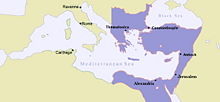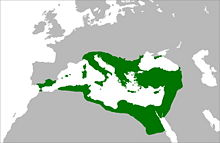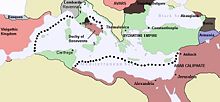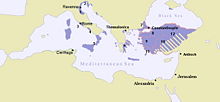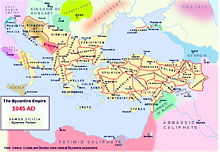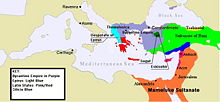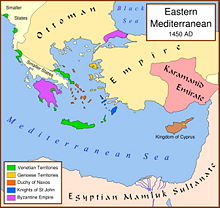Timeline of Orthodoxy in Greece
(This is a large page that blanks out when edited as a full page, please edit one section at a time.)
The History of the Church is a vital part of the Orthodox Christian faith. Orthodox Christians are defined significantly by their continuity with all those who have gone before, those who first received and preached the truth of Jesus Christ to the world, those who helped to formulate the expression and worship of our faith, and those who continue to move forward in the unchanging yet ever-dynamic Holy Tradition of the Orthodox Church.
This is a timeline regarding the presence of Orthodoxy in Greece. The history of Greece traditionally encompasses the study of the Greek people, the areas they ruled historically, as well as the territory now composing the modern state of Greece.
Christianity was first brought to the geographical area corresponding to modern Greece by the Apostle Paul, although the church’s apostolicity also rests upon St. Andrew who preached the gospel in Greece and suffered martyrdom in Patras, Titus, Paul’s companion who preached the gospel in Crete where he became bishop, Philip who, according to the tradition, visited and preached in Athens, Luke the Evangelist who was martyred in Thebes, Lazarus of Bethany, Bishop of Kittium in Cyprus, and John the Theologian who was exiled on the island of Patmos where he received the Revelation recorded in the last book of the New Testament. In addition, the Theotokos is regarded as having visited the Holy Mountain in 49 AD according to tradition. Thus Greece became the first European area to accept the gospel of Christ. Towards the end of the 2nd century the early apostolic bishoprics had developed into metropolitan sees in the most important cities. Such were the sees of Thessaloniki, Corinth, Nicopolis, Philippi and Athens.
By the 4th century almost the entire Balkan peninsula constituted the Exarchate of Illyricum which was under the jurisdiction of the bishop of Rome. Illyricum was assigned to the jurisdiction of the patriarch of Constantinople by the emperor in 732. From then on the Church in Greece remained under Constantinople till the fall of the Byzantine empire to the Turks in 1453. As an integral part of the Ecumenical Patriarchate the church remained under its jurisdiction up to the time when Greece won her freedom from Turkish domination.[1] During the Ottoman occupation up to 6,000 Greek clergymen, ca. 100 Bishops, and 11 Patriarchs knew the Ottoman sword.[2]
The Greek War of Independence of 1821-28, while leading to the liberation of southern Greece from the Turkish yoke, created anomalies in ecclesiastical relations, and in 1850 the Endemousa Synod in Constantinople declared the Church of Greece autocephalous.
In the twentieth century during much of the period of communism, the Church of Greece saw itself as a guardian of Orthodoxy. It cherishes its place as the cradle of the primitive church and the Greek clergy are still present in the historic places of Istanbul and Jerusalem, and Cyprus.[3] The autocephalous Church of Greece is organised into 81 dioceses, however 35 of these are nominally under the jurisdiction of the Ecumenical Patriarchate of Constantinople but are administered as part of the Church of Greece (except for the dioceses of Crete, the Dodecanese, and Mount Athos which are under the direct jurisdiction of the Patriarchate of Constantinople).
The Archbishop of Athens and All Greece presides over both a standing synod of twelve metropolitans (six from the new territories and six from southern Greece), who participate in the synod in rotation and on an annual basis, and a synod of the hierarchy (in which all ruling metropolitans participate), which meets once a year.
The population of Greece is 11.1 million (UN, 2007), 98% of which are Greek Orthodox (CIA World Factbook).
Contents
Apostolic era (33-100)
- ca. 47-48 Apostle Paul's mission to Cyprus.
- ca. 49 Paul's mission to Philippi, Thessaloniki and Veria.
- 49 Paul's mission to Athens.
- ca. 51-52 Metropolis of Korinthos founded in its Apostolic during Paul's first mission to Corinth; Paul writes his two Epistles to the Thessalonians.
- ca. 54 Paul writes his First Epistle to the Corinthians.
- ca. 55 Paul revisits Corinth.
- ca. 56 Paul revisits Macedonia; he writes his Second Epistle to the Corinthians.
- ca. 61 Paul shipwrecked in Crete.
- 62 Crucifixion of Apostle Andrew in Patras.
- ca. 95 Apocalypse of John written on the island of Patmos.
- 96 Martyrdom of Dionysius the Areopagite of the Seventy.
- 100 Death of St. John the Theologian in Ephesus.
Ante-Nicene era (100-325)
- ca. 100 During the second and third centuries, Greece was divided into provinces including Achaea, Macedonia, and Moesia.
- ca. 120 Martyrdom of Eleutherios and his mother Anthia.
- 124 Apostles Quadratus and Aristides present Christian apologies to Emperor Hadrian at Athens.
- 128 Aquila's Greek translation of the Old Testament.
- ca. 130 Death of Apostle Quadratus, of the Seventy.
- 156 Martyrdom of Polycarp of Smyrna.
- 180-192 Theodotion's Greek translation of the Old Testament.
- 193-211 Symmachus' Greek translation of the Old Testament.
- 202 Death of Great Martyr Charalampos, Bishop of Magnesia.
- 210 Hippolytus of Rome, bishop and martyr and last of Greek-speaking fathers in Rome, writes Refutation of All Heresies (Philosophumena), and Apostolic Tradition.
- ca 250 Matrydom of Christopher of Lycia; martyrdom of Cyprian and Justina at Nicomedia.
- ca. 251 Martyric death of Isidore of Chios under the persecutions of Decius.
- 270 Death of Gregory the Wonderworker, founder of the Church in Cappadocia.
- 286 Martyrs Timothy and Mavra.
- 302 20,000 Martyrs burned at Nicomedia.
- 303 Death of Great-Martyr Panteleimon and martyrdom of George the Trophy-bearer at Nicomedia.
- 304 Death of Virgin-Martyr Anysia of Thessaloniki.
- 306 Martyric death of Demetrios in Thessaloniki.
- 306-37 Reign of Emperor Constantine the Great.
- ca. 306 Death of Great-Martyr Barbara of Nicomedia; death of Bp. Parthenios of Lampsacus.
- 313 Edict of Milan issued by Constantine the Great and co-emperor Licinius, officially declaring religious freedom in the Roman Empire.
- 314 Council of Ancyra held.
- 316 Death of Blaise of Sebaste.
- 319 Matyrdom of Theodore Stratelates ("the General"), under Licinius.
Patriarchate of Rome Era (325-732)
Nicene era (325-451)
- 325 First Ecumenical Council held in Nicea, condemning Arianism, setting the Paschalion, and issuing the first version of the Nicene Creed, also establishing the supremacy of honor of the Apostolic Sees as Rome, followed by Alexandria, Antioch, and Jerusalem.
- 330 Byzantium refounded as Constantinople / New Rome and Christian capital of the Roman Empire.
- 333 Constantine commissions Eusebius, to prepare 50 copies of the Bible for churches in the new capital.
- 335 Building of the Protaton church at Karyes (Athos) , dedicated to the Dormition of the Virgin Mary, oldest church on Mount Athos.
- ca. 330-337 Church of Panagia Ekatontapyliani - Hundred Doors (Paros) founded by St. Helen, during her pilgrimage to the Holy Land.
- 337 Under Constantine the Great Greece was part of the prefectures of Macedonia and Thrace.
- 340-570 Constantinople overtakes Rome as the largest city in the world by population.
- 342 Death of Nicholas of Myra.
- 348 Death of Spyridon of Trimythous.
- 358 Basil the Great founds monastery of Annesos in Pontus, the model for Eastern monasticism.
- 359 Councils of Seleucia in the east and Rimini in the west.
- 360 First church of Hagia Sophia inaugurated by Emperor Constantius II.
- 364 Council of Laodicea held.
- 375 Basil the Great writes On the Holy Spirit, confirming the divinity of the Holy Spirit.
- 378 Visigoths defeat Emperor Valens at the Battle of Adrianople, permanently weakening northern borders of the empire.
- 379 Death of Basil the Great.
- 380 Christianity established as the official faith of the Roman Empire by Emperor Theodosius the Great.
- 381 Second Ecumenical Council held in Constantinople, condemning Macedonianism/Pneumatomachianism and Appollinarianism, declaring the divinity of the Holy Spirit, confirming the previous Ecumenical Council, and completing the Nicene-Constantinopolitan Creed.
- 386 Panagia Soumela Monastery founded in Trebizond, Pontus, Asia Minor, after St. Luke's Icon of the Mother of God appears at Mt. Mela.
- 391 Death of Gregory the Theologian.
- 391-92 Closing of all non-Christian temples in the Empire; Theodosius the Great ends pagan Eleusinian Mysteries by decree.
- 394 Epiphanius of Salamis (Cyprus) attacks teachings of Origen as heretical.
- 395 Death of Gregory of Nyssa; re-division of Empire with death of Emperor Theodosius the Great.
- ca. 395 Theodosius I divided the prefecture of Macedonia into the provinces of Creta, Achaea, Thessalia, Epirus Vetus, Epirus Nova, and Macedonia; the Aegean islands formed the province of Insulae in the prefecture of Asiana; the placing of the cincture (sash) of the Most Holy Theotokos in the Church of the Virgin in Halkoprateia-Constantinople (395-408).
- 398 John Chrysostom becomes Archbishop of Constantinople.
- 403 Synod of the Oak held near Chalcedon, deposing and exiling John Chrysostom.
- 407 Death of John Chrysostom in exile.
- 425 University of Constantinople founded as the first university in the world.
- 431 Third Ecumenical Council held in Ephesus, condemning Nestorianism and Pelagianism, confirming the use of the term Theotokos to refer to the Virgin Mary, and confirming autocephaly of Church of Cyprus.
- 438 Codex Theodosianus published.
- 440 Death of Alexios the Man of God, Fool-for-Christ.
- 447 Earthquake in Constantinople, when a boy was lifted up to heaven and heard the Trisagion.
- 449 Robber Synod of Ephesus, presided over by Dioscorus of Alexandria, with an order from the emperor to acquit Eutyches the Monophysite.
Early Byzantine era (451-843)
- 451 Fourth Ecumenical Council meets at Chalcedon, condemning Eutychianism and Monophysitism, affirming doctrine of two perfect and indivisible but distinct natures in Christ, and recognizing Church of Jerusalem as patriarchate.
- 452 Second finding of the Head of John the Forerunner.
- 457 First coronation of Byzantine Emperor by patriarch of Constantinople.
- 462 Indiction moved to September 1; Studion Monastery founded.
- 463 Death of Patapius of Thebes.
- ca.471 Patriarch Acacius of Constantinople was first called "Oikoumenikos" (Ecumenical).
- 484 Acacian Schism.
- 502 Start of Byzantine-Sassanid wars, lasting until 562.
- 518 Patriarch John II of Constantinople is addressed as "Oikoumenikos Patriarches" (Ecumenical Patriarch).
- 519 Eastern and Western churches reconciled with end of Acacian Schism.
- 529 Emperor Justinian closes the School of Athens.
- 529-534 Justinian's Corpus Juris Civilis issued; Justinian's Novella 131 formulated the proposed government of universal Christendom by five patriarchal sees under the auspices of a single universal empire (Pentarchy).
- 532 Justinian the Great orders building of Hagia Sophia;
- 537 Construction of Hagia Sophia in Constantinople completed; Justinian decrees that all dates must include the Indiction.
- ca. 540 Death of Osios David of Thessaloniki.
- 543 Doctrine of apokatastasis condemned by Synod of Constantinople.
- 553 Fifth Ecumenical Council held in Constantinople in an attempt to reconcile Chalcedonians with non-Chalcedonians—the Three Chapters of Theodore of Mopsuestia, Theodoret of Cyrrhus, and Ibas of Edessa are condemned for their Nestorianism, and Origen and his writings are also condemned.
- 553 Ostrogoth kingdom in Italy conquered by the Byzantine Empire after the Battle of Mons Lactarius.
- 563 Re-consecration of Hagia Sophia in Constantinople after its dome is rebuilt.
- 580 Slavs begin to migrate into the Balkans and Greece.
- ca. 590 Parthenon in Athens converted into a Christian church dedicated to Agia Sophia.
- 586 St. Demetrios of Thessaloniki saves Thessaloniki from Avar-Slav siege.
- 602 Final series of wars between Byzantine Empire and Sassanid Empire.
- 610 Heraclius changes official language of the Empire from Latin to Greek, already the lingua franca of the vast majority of the population.
- 612 Holy Sponge and Holy Lance brought to Constantinople from Palestine.
- 617 Persian Army conquers Chalcedon after a long siege.
- 620 Slavs attack Thessaloniki.
- 626 Akathist Hymn to the Virgin Mary written, after Constantinople liberated from a siege of 80,000 Avars, Slavs and the Persian fleet.
- 627 Emperor Heraclius decisively defeats Sassanid Persians at Battle of Nineveh, recovering True Cross and breaking power of the Sassanid dynasty.
- 646 Alexandria recaptured by Muslim Arabs after a Byzantine attempt to retake Egypt fails, ending nearly ten centuries of Greco-Roman civilization in Egypt.
- 648 Pope Theodore I of Rome excommunicates patriarch Paul II of Constantinople.
- 649 Arabs invade and conquer Cyprus.
- 650 The Patriarchate of Constantinople counted 32 metropoles, or capitals of ecclesiastical provinces, 1 autocephalous metropolis, 34 autocephalous archbishoprics, and 352 bishoprics -- a grand total of 419 dioceses.
- 654 Invasion of Rhodes by Arabs.
- 662 Parthenon in Athens rededicated in honour of the Mother of God as "Panagia Atheniotissa" (Panagia of Athens); death of Maximus the Confessor.
- 669-78 First Arab siege of Constantinople; at Battle of Syllaeum Arab fleet destroyed by Byzantines through use of Greek Fire, ending immediate Arab threat to eastern Europe.
- 680-681 Sixth Ecumenical Council held in Constantinople, condemning Monothelitism and affirming Christology of Maximus the Confessor, affirming that Christ has both a human will and a divine will; Patr. Sergius of Constantinople and Pope Honorius of Rome are both explicitly anathematized for their support of Monothelitism.
- 685 First monastics come to Mount Athos;
- 688 Emperor Justinian II and Caliph al-Malik sign treaty neutralizing Cyprus.
- 692 The "Pentarchy" form of government of universal Christendom by five patriarchal sees received formal ecclesiastical sanction at the Council in Trullo, held in Constantinople, which ranked the five sees as Rome, Constantinople, Alexandria, Antioch, and Jerusalem;
- 705 Long period of fighting begins between Trebizond in eastern Asia Minor and the Arabs.
- 706 Greek replaced by Arabic as administrative language in Egypt.
- 707 Byzantines lose Balearic Islands to Moors;
- 710 Pope Constantine makes last papal visit to Constantinople before 1967.
- 712 Death of Andrew of Crete.
- 717-18 Second Arab siege of Constantinople.
- 720 Martyrdom of Nicholas the New of Vounina.
- 726 Iconoclast Emperor Leo the Isaurian starts campaign against icons.
Patriarchate of Constantinople Era (732-1850)
- 732-33 Byzantine Emperor Leo the Isaurian transfers Southern Italy (Sicily and Calabria), Greece, and the Aegean from the jurisdiction of the Pope to that of the Ecumenical Patriarch in response to Pope St. Gregory III of Rome's support of a revolt in Italy against iconoclasm, adding to the Patriarchate about 100 bishoprics; the Iconoclast emperors took away from the Patriarch of Antioch 24 episcopal sees of Byzantine Isauria, on the plea that he was a subject of the Arab caliphs; the jurisdiction of the Patriarch of Constantinople became co-extensive with the limits of the Byzantine Empire.
- 734 Death of Peter the Athonite, commonly regarded as one of the first hermits of Mount Athos.
- 739 Emperor Leo III (717-41) publishes his Ecloga , designed to introduce Christian principle into law; Byzantine forces defeat Umayyad invasion of Asia Minor at Battle of Akroinon.
- 746 Byzantine forces regain Cyprus from the Arabs.
- 754 Iconoclastic Council held in Constantinople under the authority of Emperor Constantine V Copronymus, condemning icons and declaring itself to be the Seventh Ecumenical Council; Constantine begins dissolution of the monasteries.
- 787 Seventh Ecumenical Council held in Nicea, condemning iconoclasm and affirming veneration of icons.
- 789 Death of Philaret the Merciful.
- 803 Death of Irene of Athens, wife of Byzantine Emperor Leo IV; St. Luke's icon brought to Agiassos on Mytiline.
- 814 Bulgarians lay siege to Constantinople; conflict erupts between Emperor Leo V and Patr. Nicephorus on the subject of iconoclasm; Leo deposes Nicephorus, Nicephorus excommunicates Leo.
- 824 Byzantine Crete falls to Arab insurgents fleeing from the Umayyad Emir of Cordoba Al-Hakam I, establishing an emirate on the island until the Byzantine reconquest in 960.
- 828 Death of Patr. Nicephorus I of Constantinople.
- ca. 829-842 Icon of the Panagia Portaitissa appears on Mount Athos near Iviron Monastery.
- 836 Death of Theodore the Studite.
- 838 Caliph al-Mu'tasim captures and destroys Ammoria in Anatolia.
- ca. 839 First Rus'-Byzantine War, where the Rus attacked Propontis (probably aiming for Constantinople) before turning east and raiding Paphlagonia.
- 840 Panagia Proussiotissa icon found near Karpenissi.
Byzantine Imperial era (843-1204)
- 843 Empress Theodora secures return of icon-worship with Triumph of Orthodoxy occuring on first Sunday of Great Lent, restoring icons to churches.
- 845 42 Martyrs of Ammoria in Phrygia taken as hostages from Ammoria to Samarra (in Iraq) and executed there.
- 850 Third Finding of the head of John the Forerunner.
- 858 Photius the Great becomes patriarch of Constantinople.
- 860 Second Rus-Byzantine War, a naval raid and the first siege of Constantinople by the Rus.
- ca. 860 Christianization of the Rus' Khaganate.
- 861 Cyril and Methodius of Thessaloniki depart from Constantinople to missionize the Slavs; Council of Constantinople attended by 318 fathers and presided over by papal legates confirms Photius the Great as patriarch and passes 17 canons.
- 864 Baptism of Prince Boris of Bulgaria; Synaxis of the Theotokos in Miasena in memory of the return of her icon.
- 867 Council in Constantinople held, presided over by Photius, which anathematizes Pope Nicholas I of Rome for his attacks on work of Greek missionaries in Bulgaria and use by papal missionaries of Filioque; Pope Nicholas dies before hearing news of excommunication; Basil the Macedonian has Emperor Michael III murdered and usurps Imperial throne, reinstating Ignatius as patriarch of Constantinople.
- 867 Death of Kassiani, Greek-Byzantine poet and hymnographer, who composed the Hymn of Kassiani, chanted during Holy Week on Holy Wednesday.
- 869-870 Robber Council of 869-870 held, deposing Photius the Great from the Constantinopolitan see and putting the rival claimant Ignatius on the throne, declaring itself to be the "Eighth Ecumenical Council."
- 870 Conversion of Serbia; Malta conquered from the Byzantines by the Arabs.
- 874 Translation of relics of Nicephorus the Confessor, interred in the Church of the Holy Apostles, Constantinople.
- 877 Death of Ignatius I of Constantinople, who appoints Photius to succeed him.
- 877 Arab Muslims conquer all of Sicily from Byzantium and make Palermo their capital.
- 879-880 Eighth Ecumenical Council held in Constantinople attended by 383 fathers passing 3 canons, confirms Photius as Patriarch of Constantinople, anathematizes additions to the Nicene-Constantinopolitan Creed, and declares that the prerogatives and jurisdiction of the Roman pope and the Constantinopolitan patriarch are essentially equal; the council is reluctantly accepted by Pope John VIII of Rome.
- 881 Death of Theoktiste of Lesbos.
- 885 Mount Athos gains political autonomy, as Emperor Basil lays down the boundaries of the monastic republic; death of Methodius.
- 892 Death of Theodora the Myrrh-gusher of Thessaloniki.
- 902 Taormina, the last Byzantine stronghold in Sicily, is captured by the Aghlabid Arabs.
- 904 Thessaloniki sacked and pillaged by Saracen pirates under Leo of Tripoli, a Greek pirate serving Saracen interests.
- 907 Third Rus-Byzantine War, a naval raid of Constantinople (or Tsargrad in Old Slavonic) led by Varangian Prince Oleg of Novgorod, which was relieved by peace negotiations.
- 911 Holy Protection of the Virgin Mary; Russian envoys visit Constantinople to ratify a treaty, sent by Oleg, Grand Prince of Rus'.
- 912 Nicholas I Mysticus becomes Patriarch of Constantinople.
- 921 Death of Irene Chrysovalantou.
- 925 Death of Peter of Argos.
- 941 Fourth Rus-Byzantine War.
- 944 City of Edessa recovered by Byzantine army, including Icon Not Made By Hands
- 953 Monastery of Hosios Loukas founded by St. Luke the Younger near Stiris (Thebes) in Greece.
- 957 Olga of Kiev baptized in Constantinople.
- 960 Emperor Nicephorus II Phocas re-captures Crete for the Byzantines.
- 961 Founding of Agia Lavra monastery in Kalavryta, Peloponesse, (the symbolic birth-place of modern Greece in 1821).
- 963 Athanasius of Athos establishes first major monastery on Mount Athos, the Great Lavra; founding of Philosophou Monastery in Dimitsana (Peloponesse).
- 965 Emperor Nicephorus II Phocas gains Cyprus completely for the Byzantines.
- 968-71 Fifth Rus-Byzantine War, resulting in a Byzantine victory over the coalition of Rus', Pechenegs, Magyars, and Bulgarians in the Battle of Arcadiopolis, and the defeat of Sviatoslav of Kiev by John I Tzimiskes.
- 969 Emperor Nikephoros II Phokas captures Antioch and Aleppo from Arabs.
- 972 Emperor John I Tzimiskes grants Mount Athos its first charter (Typikon).
- 975 Emperor John I Tzimiskes in a Syrian campaign takes Emesa, Baalbek, Damascus, Tiberias, Nazareth, Caesarea, Sidon, Beirut, Byblos and Tripoli, but fails to take Jerusalem.
- 980 Revelation of the Axion Estin (the hymn "It Is Truly Meet"), with the appearance of the Archangel Gabriel to a monk on Mount Athos.
- 987 Sixth Rus-Byzantine War, where Vladimir of Kiev dispatches troops to the Byzantine Empire to assist Emperor Basil II with an internal revolt, agreeing to accept Orthodox Christianity as his religion and bring his people to the new faith.
- 988 Baptism of Rus' begins with the conversion of Vladimir of Kiev who is baptized at Chersonesos, the birthplace of the Russian and Ukrainian Orthodox churches; Vladimir marries Anna, sister of Byzantine emperor Basil II.
- 11th c. Kaisariani Monastery is founded on the slopes of Mount Hymettos, one of the oldest and most important monasteries in Attica; death Theodora of Vasta.
- 1009 Patr. Sergius II of Constantinople removes name of Pope Sergius IV of Rome from diptychs of Constantinople, because the pope had written a letter to the patriarch including the Filioque.
- 1022 Death of Symeon the New Theologian.
- 1025 Greece is divided into themes including Crete, the Peloponnese, Hellas, Nicopolis, Larissa, Cephalonia, Thessalonica, the Cyclades and the Aegean.
- 1042 Founding of Nea Moni Monastery on Chios.
- 1043 University of Constantinople is re-organized under Michael Psellos.
- 1053 Death of Lazarus the Wonder-worker of Mount Galesius near Ephesus.
- 1054 The Great Schism between Orthodox East and Latin West.
- 1068 By the time of the arrival of the first Seljuk Turks to Anatolia, the religious war between Byzantium and Islam had run a course of four centuries.
- 1071 Seljuk Turks defeat Byzantines at the Battle of Manzikert, beginning Islamification of Asia Minor; Norman princes led by Robert Guiscard capture Bari, the last Byzantine stronghold in Italy, bringing to an end over five centuries of Byzantine rule in the south.
- ca. 1071-1176 Byzantine epic poem "Digenes Akrites" is written, set in the ninth and tenth centuries, inspired by the almost continuous state of warfare with the Arabs in eastern Asia Minor, presents a comprehensive picture of the intense frontier life of the Akrites, the border guards of the Byzantine Empire.
- 1073 Seljuk Turks conquer Ankara.
- 1077 Seljuks capture Nicea.
- 1087 Translation of the relics of Nicholas of Myra from Myra to Bari.
- 1083 Metropolis of Paronaxia separates from the Metropolis of Rhodes.
- 1088-93 Emperor Alexios Komnenos I gave the island of Patmos to Blessed Christodoulos of Patmos to develop as an independent monastic state; founding of monastery of John the Theologian on Patmos.
- 1093 Death of Christodoulos the Wonderworker of Patmos.
- 1118-1137 Imperial monastery of Christ Pantocrator founded.
- 1127-1145 Constantinople largest city in the world by population.
- 1147 Roger II of Sicily takes Corfu from the Byzantine Empire, and pillages Corinth, Athens and Thebes.
- 1176 Sultanate of Rum defeats Byzantine Empire in the Battle of Myriokephalon, marking end of Byzantine attempts to recover Anatolian plateau.
- 1192-1571 Church of Cyprus is subordinated to a Latin Hierarchy established by the Crusaders.
- 12th c. Skete life begins in Meteora.
Latin Occupation (1204-1456)
- 1204 Fourth Crusade sacks Constantinople, laying waste to the city and stealing many relics and other items; Great Schism generally regarded as having been completed by this act; Venetians use the imperial monastery of Christ Pantocrator as their headquardters in Constantinople.
- 1204 Latin Occupation of mainland Greece under Franks and Venetians: the Latin Empire of Constantinople, Latin Kingdom of Thessalonica, the Principality of Achaea, and the Duchy of Athens; The Venetians controlled the Duchy of the Archipelago in the Aegean.
- 1205 Latins annex Athens and convert the Parthenon into a Roman Catholic Church - Santa Maria di Athene, later Notre Dame d'Athene.
- 1211 Venetian crusaders conquer Byzantine Crete, retaining it until ousted by Ottoman Turks in 1669.
- 1224 The Byzantines recover Thessaloniki and surrounding area, liberated by the Greek ruler of Epirus Theodore Ducas Comnenus.
- 1235 St. Olympiada and nuns martyred by pirates on Mytilene of Lesbos
- 1249 Mystras citadel built by Franks in the Peloponnese.
- 1258 Michael VIII Palaiologos seizes the throne of the Nicaean Empire, founding the last Roman (Byzantine) dynasty, beginning reconquest of Greek peninsula from Latins.
- 1259 Byzantines defeat Latin Principality of Achaea at the Battle of Pelagonia, marking the beginning of the Byzantine recovery of Greece.
- ca. 1259-80 Martyrdom by Latins of monks of Iveron Monastery.
- 1261 End of Latin occupation of Constantinople and restoration of Orthodox patriarchs; Emperor Michael VIII Palaiologos makes Mystras seat of the new Despotate of Morea, where a Byzantine renaissance occurred.
- 1265-1310 Arsenite Schism of Constantinople, beginning when Patr. Arsenius Autoreianos excommunicated emperor Michael VIII Palaiologos.
- 1274 Orthodox attending the Second Council of Lyons, accept supremacy of Rome and filioque clause.
- 1275 Unionist Patr. of Constantinople John XI Beccus elected to replace Patr. Joseph I Galesiotes, who opposed Council of Lyons.
- 1275 Persecution of Athonite monks by Emp. Michael VIII and Patr. John XI Beccus; death of 26 martyrs of Zographou monastery on Mount Athos, martyred by the Latins.
- 1281 Pope Martin IV authorizes a Crusade against the newly re-established Byzantine Empire in Constantinople, excommunicating Emperor Michael VIII Palaiologos and the Greeks and renouncing the union of 1274; French and Venetian expeditions set out toward Constantinople but are forced to turn back in the following year due to the Sicilian Vespers.
- 1283 Accommodation with Rome officially repudiated.
- 1287 Last record of Western Rite Monastery of Amalfion on Mount Athos.
- 14th c. "Golden Age" of Thessaloniki in both literature and art, many churches and monasteries built.
- 1300-1400 The "Chronicle of Morea" (Το χρονικό του Μορέως) narrates events of the establishment of feudalism in mainland Greece, mainly in the Morea/Peloponnese, by the Franks following the Fourth Crusade, covering a period from 1204 to 1292.
- 1309 Rhodes falls to the Knights of St. John, who establish their headquarters there, renaming themselves the "Knights of Rhodes".
- 1310 Arsenite Schism of Constantinople is brought to an end by the reconciliation of the Arsenites to the Josephites.
- 1326 The city of Prusa in Asia Minor falls to the Ottoman Turks after a nine-year siege.
- 1331 The city of Nicaea, capital of the Empire only 100 years previously, falls to the Ottoman Turks.
- 1336 Meteora in Greece are established as a center of Orthodox monasticism.
- 1337 Nicomedia captured by Ottoman Turks.
- 1338 Gregory Palamas writes Triads in defense of the Holy Hesychasts, defending the Orthodox practice of hesychast spirituality and the use of the Jesus Prayer.
- 1341-47 Byzantine civil war between John VI Cantacuzenus (1347–54) and John V Palaeologus (1341–91).
- 1341-51 Three sessions of the Ninth Ecumenical Council held in Constantinople, affirming hesychastic theology of Gregory Palamas and condemning rationalistic philosophy of Barlaam of Calabria.
- 1354 Ottoman Turks make first settlement in Europe at Gallipoli.
- 1359 Death of Gregory Palamas.
- 1360 Death of John Koukouzelis the Hymnographer.
- 1365 Ottoman Turks made Adrianople their capital.
- 1382 Founding of the Great Meteora Monastery.
- 1390 Ottomans take Philadelphia, last significant Byzantine enclave in Anatolia.
- 1391-98 Ottoman Turks unsuccessfully besiege Constantinople for the first time.
- 1422 Second unsuccessful Ottoman siege of Constantinople.
- 1426 Death of New Martyr Ephraim of Nea Makri.
- 1429 The Turks capture Thessaloniki.
- 1430 The monks of Mount Athos submit to Sultan Murad II and keep their autonomy.
- 1438 Council of Florence unsuccessfully tries to unit Greek East and Latin West.
- 1450 Death of Empress Helena Palaeologus (St. Ipomoni of Loutraki).
- 1452 Unification of Roman Catholic and Greek Orthodox Churches in Hagia Sophia on West's terms, when Emperor Constantine XI Palaiologos, under pressure from Rome, allows the union to be proclaimed.
- 1453 Constantinople falls to invasion of the Ottoman Turks, ending Roman Empire; Hagia Sophia turned into a mosque; martyrdom of Constantine XI Palaiologos, last of the Byzantine Emperors; many Greek scholars escape to the West with books that become translated into Latin, triggering the Renaissance; beginning of the lamentation folk songs known as "Moirologia", or dirges (Byzantine secular music).
- ↑ World Council of Churches: Church of Greece.
- ↑ Christodoulos (Paraskevaides) of Athens. Address to the Conference organised by the Synodal Committee on European Issues, entitled “Islam: the extent of the problematics”. Holy Monastery of Penteli, Attica, 12/5/2007.
- ↑ The Globe and Mail (Canada's National Newspaper). "Orthodox Church at Crossroads." November 10, 1995. p.A14.
